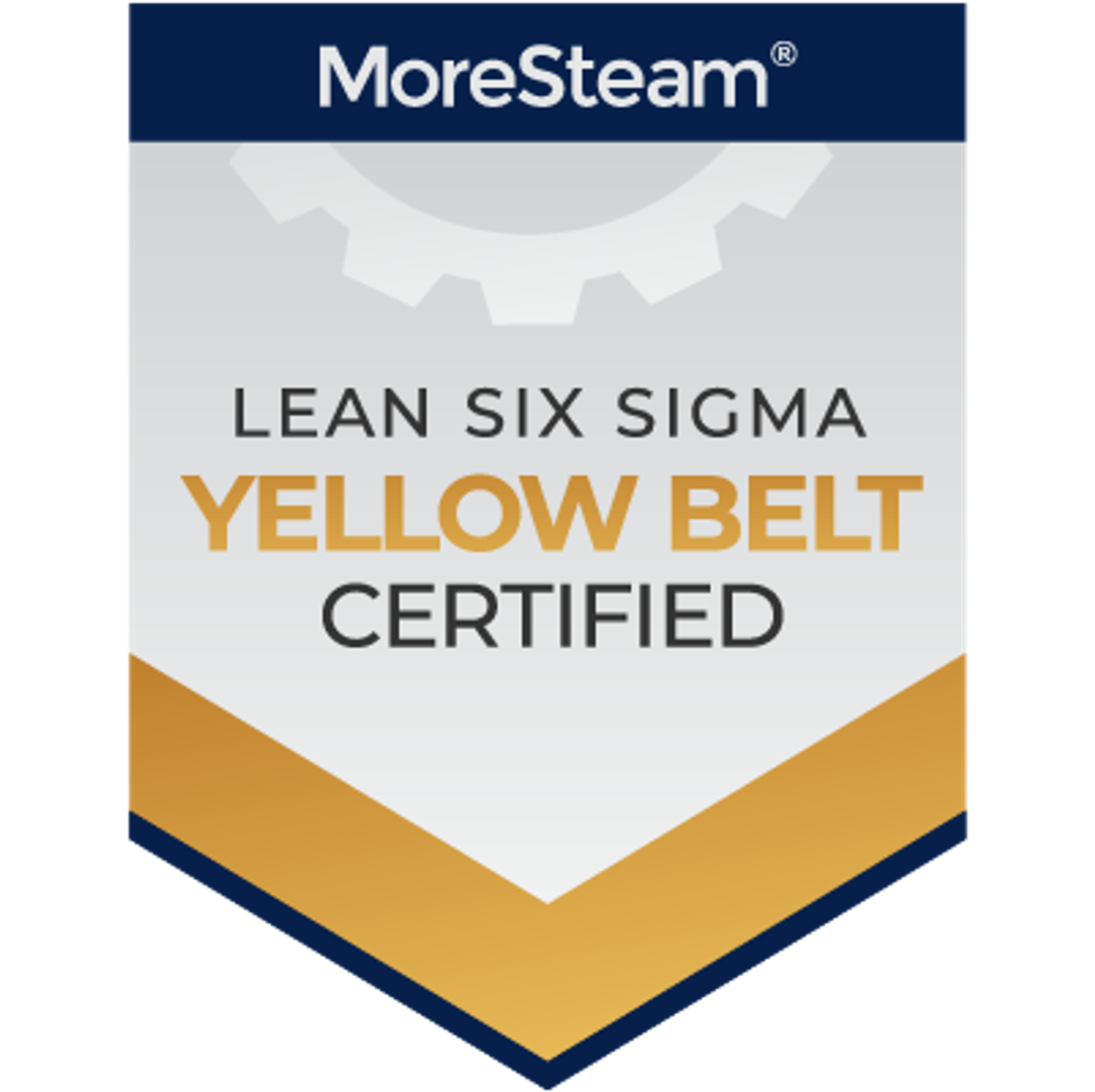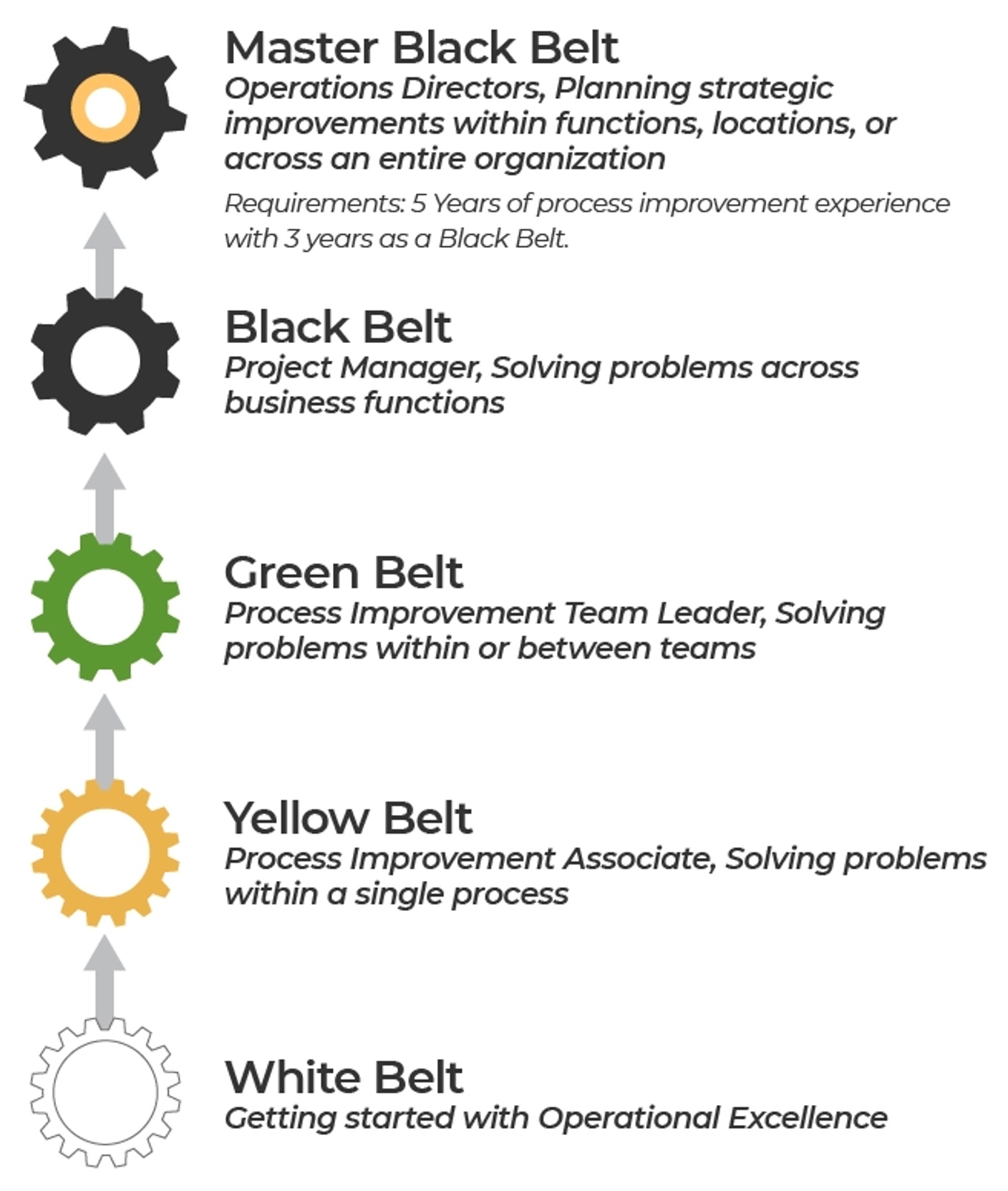
What is a Lean Six Sigma Yellow Belt?
A Lean Six Sigma Yellow Belt is a professional qualification that represents foundational training in Lean Six Sigma principles. Yellow Belts play a crucial role in supporting process improvement projects, helping teams apply Lean Six Sigma tools and techniques to enhance efficiency and productivity. They often work under the guidance of Green and Black Belts, assisting with data collection, process mapping, and identifying areas of improvement.
Yellow Belts are typically team members from various departments — Operations, Customer Service, IT, or Manufacturing — who contribute to the success of improvement initiatives by providing valuable insights from their areas of expertise. Many organizations invest in Yellow Belt training to build a culture of continuous improvement and ensure that team members understand how their roles contribute to organizational success.
Yellow Belt Quick Facts
Average Salary: Yellow Belts earn $111,254* annually, depending on industry and experience.
Cost Savings: Yellow Belts can save companies $75,000* or more per project by reducing waste.
Belt Level: A Yellow Belt is an introductory Six Sigma level, positioned below Green and Black Belts.
*As of 2024, reported in 'Salary by highest Six Sigma Belt—U.S. and Canadian respondents',' Quality Progress, December 2024.
Yellow Belts on the Job
What type of project work is expected from a Yellow Belt?
A Six Sigma Yellow Belt supports improvement projects by assisting Green, Black, and Master Black Belts with tasks like data collection, process mapping, and identifying inefficiencies. Yellow Belts play a critical role in team efforts to solve problems that matter to both customers and the organization. While they may not lead projects, their contributions are vital for implementing Lean Six Sigma tools and methodologies.
Yellow Belts often focus on supporting smaller, localized improvements in safety, quality, and efficiency within their immediate work areas. For example, a retail employee trained as a Yellow Belt might analyze inventory data to minimize stockouts, or a hospital administrator might help map patient intake processes to reduce waiting times. By combining hands-on experience with foundational Lean Six Sigma skills, a certified Lean Six Sigma Yellow Belt can help ensure the success of improvement initiatives and build a culture of continuous improvement within their team.
Key Skills and Competencies of a Lean Six Sigma Yellow Belt
Yellow Belts are equipped with foundational skills and tools to contribute to process improvement efforts and support Lean Six Sigma projects. By focusing on teamwork and data collection, they help drive incremental changes that enhance efficiency and quality.
Problem Solving
Assists in identifying problems and suggesting practical solutions
Process Mapping
Helps visualize workflows to identify inefficiencies and areas for improvement
Data Collection
Gathers and organizes data to support project decisions
Team Collaboration
Works effectively within a team to contribute to project success
5S Methodology
Supports workplace organization and standardization efforts
Communication
Bridges gaps between team members by sharing insights and updates
DMAIC Knowledge
Understands the framework and applies it at a foundational level
Waste Identification
Recognizes opportunities to eliminate non-value-added activities
Industries and Career Paths for Yellow Belt
Lean Six Sigma Yellow Belt skills are applicable across diverse industries, from healthcare to technology. These roles enable professionals to drive quality, efficiency, and cost savings within their organizations.
- Healthcare: Yellow Belts assist teams in identifying inefficiencies, supporting data collection, and mapping processes to improve patient care, reduce wait times, and streamline resource utilization.
- Finance: In finance, Yellow Belts support workflow optimization by helping teams collect and organize data, identify potential bottlenecks, and implement foundational process improvements.
- Manufacturing: Yellow Belts contribute to reducing waste and improving workflows by assisting with process mapping, identifying inefficiencies, and gathering data to support Lean Six Sigma initiatives.
- Technology: Yellow Belts in tech play a supportive role by helping teams document processes, analyze data, and ensure alignment with project goals to enhance productivity and efficiency.
- Retail and Customer Service: In retail and customer-facing roles, Yellow Belts help improve the customer experience by supporting process standardization, improving service quality, and contributing to smoother day-to-day operations.
What to Look for in a Lean Six Sigma Yellow Belt Course
Choosing the right Lean Six Sigma Yellow Belt course is about more than just cost or time commitment—it's about finding a program that builds a solid foundation in Lean Six Sigma principles. A quality Yellow Belt course should equip participants with the knowledge to assist in process improvement projects, understand key concepts like waste identification, and contribute meaningfully to team efforts.
Training Formats for Different Learning Styles
- Self-Paced Online: This format is ideal for learners who prefer the convenience of progressing through course materials at their own pace. Participants can explore case studies, videos, and exercises designed to help them grasp foundational Lean Six Sigma concepts.
- Tailored Options for Specific Professions: For example, our Yellow Belt for CPAs course is customized for accounting professionals, offering Lean Six Sigma training that applies directly to their work environments and challenges. This specialized approach ensures participants gain relevant, actionable skills.
What Does it mean to be Yellow Belt Certified?
Yellow Belt certification standards can vary, so it's important to choose a program with a robust curriculum. At MoreSteam, certification means more than passing an exam—it signifies a thorough understanding of Lean Six Sigma basics and the ability to support improvement initiatives effectively. Graduates receive a printed certificate and a digital badge to proudly showcase their achievement.
Key Takeways for Yellow Belts
- Responsibilities: Yellow Belts support process improvement teams by gathering data, assisting with process mapping, and identifying inefficiencies.
- Core Skills: Building foundational knowledge of Lean Six Sigma principles, including waste identification, process mapping, and effective communication.
- Applicability Across Industries: Yellow Belts contribute to process improvements in industries like healthcare, manufacturing, customer service, and retail.
- Professional Growth: Yellow Belt certification provides an excellent entry point to Lean Six Sigma, enhancing collaboration skills and preparing participants for more advanced roles.
- Confidence in Collaboration: MoreSteam training equips Yellow Belts with the tools and confidence to play a meaningful role in improvement initiatives.
Earn CPE Credits While Advancing Your Skills with Lean Six Sigma Yellow Belt
Our Lean Six Sigma Yellow Belt courses are designed to meet a variety of professional needs, and for CPAs, we offer a specialized course that provides Continuing Professional Education (CPE) credits. This self-paced, online course introduces the fundamentals of Lean Six Sigma while helping finance professionals meet their certification requirements.
- CPE Accredited: Approved for CPAs seeking relevant and practical education.
- Flexible Learning: Learn at your own pace, on your own schedule.
- Targeted for Professionals: Build problem-solving and process improvement skills tailored to enhance your financial expertise.
Whether you're looking to streamline processes, reduce errors, or boost productivity, this course provides the tools and insights you need—all while earning the credits to advance your career.

Want to Learn More About Lean Six Sigma? Curious About the Other Belt Levels?
Lean Six Sigma is a journey of continuous learning and growth, with each belt level offering unique skills and opportunities. If you're curious about how the Yellow Belt fits into the bigger picture or want to explore Lean Six Sigma in more detail, check out these resources:
What is Lean Six Sigma?: Discover the core principles of Lean Six Sigma and how it transforms organizations through continuous improvement.
Lean Six Sigma Belt Levels Explained: Discover how each level builds on the last and where the different belts fit into the continuous improvement process.
What is DMAIC Methodology?: Learn about the structured problem-solving process at the heart of Lean Six Sigma.
The History of Lean Six Sigma: An insightful interview exploring the origins and evolution of Lean Six Sigma.

Frequently Asked Questions
Still have questions? We're here to help.
614-602-8190
No Robots. Only humans.
support@moresteam.com
You'll still get a human here, too.

